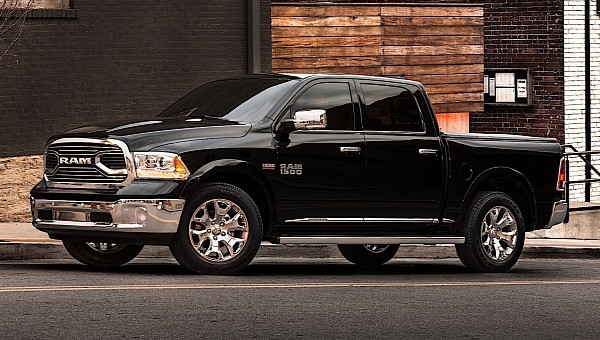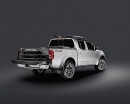Pickup trucks are very popular among American drivers, accounting for one in five passenger vehicles on U.S. roads. Their size and weight make them dangerous for other road users, yet carmakers were not keen to install AEB and other crash avoidance systems on them.
A new study by the Insurance Institute for Highway Safety (IIHS) shows that Automatic emergency braking (AEB) systems could reduce rear-end crash rates for pickup trucks by more than 40 percent. This could be a boon, considering that pickups are heavy vehicles that could be dangerous to people in smaller cars or on foot in case of an accident.
The IIHS has examined police-reported crashes from 25 states for 2017-2020 and came up with the rate at which pickup trucks rear-ended other vehicles per registered vehicle year. The result was eye-opening, with a crash rate 43% lower for pickups equipped with AEB than those without it. Rear-end injury crash rates were 42% lower, while serious and fatal injury crash rates were also down 77%.
“These numbers confirm that AEB is reducing crashes for pickups, just as it is for cars, SUVs, and large trucks,” said study author Jessica Cicchino, vice president of research at IIHS. “The faster automakers can make sure that every pickup they sell has this important safety feature, the better.”
Despite the heightened danger, pickups are less likely to feature AEB than cars or SUVs. According to IIHS, an AEB system was standard on 5% of the registered pickups in the U.S. last year, compared to 10% of cars and 18% of SUVs. The feature was optional on 10% of pickups, 15% of cars, and 22% of SUVs. Moreover, pickups that lack AEB also lack systems that detect and avoid pedestrians. Although less effective at night, these systems could reduce pedestrian crashes by 27%.
AEB systems use cameras and radar sensors to detect when a vehicle is getting dangerously close to the one in front of it. The system issues a visual or audible warning to get the driver’s attention, pre-conditions the braking system to maximize effect, and then initiates braking on its own if the driver doesn’t respond. This could significantly reduce the vehicle speed before a crash or even avoid the collision altogether.
The carmakers started equipping all new cars and SUVs with AEB and crash-avoiding systems under a voluntary agreement that IIHS and the NHTSA brokered. Nevertheless, the deal will not cover pickups with a gross vehicle weight (GVW) rating of more than 8,500 pounds until 2025. The Class 3 trucks, having a GVW rating of 10,001-14,000 pounds, do not fall under this deal at all
“The voluntary agreement covers most passenger vehicles, and federal regulations will soon require AEB on tractor-trailers. But there’s a substantial gap in between for Class 3-6 trucks, which include some heavy-duty pickups as well as larger vehicles like some garbage trucks and buses,” Cicchino said.
IIHS recommends that carmakers focus on equipping all new vehicles with AEB systems able to work at higher speeds and detect pedestrians in the dark as well as in the daytime. More than other types of vehicles, pickups are usually driven in rural areas with higher average speeds, and the roads typically lack streetlights.
The IIHS has examined police-reported crashes from 25 states for 2017-2020 and came up with the rate at which pickup trucks rear-ended other vehicles per registered vehicle year. The result was eye-opening, with a crash rate 43% lower for pickups equipped with AEB than those without it. Rear-end injury crash rates were 42% lower, while serious and fatal injury crash rates were also down 77%.
“These numbers confirm that AEB is reducing crashes for pickups, just as it is for cars, SUVs, and large trucks,” said study author Jessica Cicchino, vice president of research at IIHS. “The faster automakers can make sure that every pickup they sell has this important safety feature, the better.”
Despite the heightened danger, pickups are less likely to feature AEB than cars or SUVs. According to IIHS, an AEB system was standard on 5% of the registered pickups in the U.S. last year, compared to 10% of cars and 18% of SUVs. The feature was optional on 10% of pickups, 15% of cars, and 22% of SUVs. Moreover, pickups that lack AEB also lack systems that detect and avoid pedestrians. Although less effective at night, these systems could reduce pedestrian crashes by 27%.
AEB systems use cameras and radar sensors to detect when a vehicle is getting dangerously close to the one in front of it. The system issues a visual or audible warning to get the driver’s attention, pre-conditions the braking system to maximize effect, and then initiates braking on its own if the driver doesn’t respond. This could significantly reduce the vehicle speed before a crash or even avoid the collision altogether.
The carmakers started equipping all new cars and SUVs with AEB and crash-avoiding systems under a voluntary agreement that IIHS and the NHTSA brokered. Nevertheless, the deal will not cover pickups with a gross vehicle weight (GVW) rating of more than 8,500 pounds until 2025. The Class 3 trucks, having a GVW rating of 10,001-14,000 pounds, do not fall under this deal at all
“The voluntary agreement covers most passenger vehicles, and federal regulations will soon require AEB on tractor-trailers. But there’s a substantial gap in between for Class 3-6 trucks, which include some heavy-duty pickups as well as larger vehicles like some garbage trucks and buses,” Cicchino said.
IIHS recommends that carmakers focus on equipping all new vehicles with AEB systems able to work at higher speeds and detect pedestrians in the dark as well as in the daytime. More than other types of vehicles, pickups are usually driven in rural areas with higher average speeds, and the roads typically lack streetlights.






